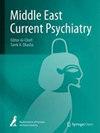The moderating role of posttraumatic growth in secondary traumatic stress–burnout relationship: a sample of child psychiatrists from Turkey
IF 1.6
Q3 PSYCHIATRY
引用次数: 0
Abstract
Secondary traumatization is a common occupational hazard for professionals working with distressed and traumatized people, especially children. If not properly managed, secondary traumatization can lead to symptoms similar to posttraumatic stress disorder. This condition is known as secondary traumatic stress (STS) and is linked to adverse mental health outcomes, such as burnout. Nevertheless, exposure to a traumatic event or its disturbing details can contribute to personal transformation, allowing an individual to move beyond pre-traumatic functioning and awareness. This process is called posttraumatic growth and is associated with positive mental health outcomes. The current study examined the relationship between STS and burnout and whether posttraumatic growth moderates this relationship in a sample of child psychiatrists. An online questionnaire was designed and distributed to participants. A total of 59 child psychiatrists working in Turkey completed measures including the Copenhagen Burnout Inventory-work burnout subscale, the Posttraumatic Growth Inventory, and the Secondary Traumatic Stress Scale. While STS was positively related to burnout (r = 0.661, p < .001), posttraumatic growth moderated this relationship. In other words, the relationship between STS and burnout was weaker for child psychiatrists with higher posttraumatic growth. Promoting posttraumatic growth may be a good way to reduce burnout among child psychiatrists. Individual or group supervision can promote posttraumatic growth by providing a supportive environment for child psychiatrists. Balancing workloads and creating time for self-care can also contribute to their growth.创伤后成长在继发性创伤压力-倦怠关系中的调节作用:来自土耳其儿童精神病学家的样本
继发性创伤是与痛苦和受创伤的人,特别是儿童打交道的专业人员常见的职业危害。如果处理不当,继发性创伤会导致类似创伤后应激障碍的症状。这种情况被称为继发性创伤应激(STS),与不良的心理健康结果有关,如倦怠。然而,暴露于创伤性事件或其令人不安的细节可以促进个人转变,使个人超越创伤前的功能和意识。这个过程被称为创伤后成长,与积极的心理健康结果有关。目前的研究在儿童精神病学家的样本中检验了STS和倦怠之间的关系,以及创伤后成长是否调节了这种关系。设计并分发了一份在线问卷给参与者。共有59名在土耳其工作的儿童精神病学家完成了测量,包括哥本哈根倦怠量表-工作倦怠子量表,创伤后成长量表和二次创伤压力量表。虽然STS与倦怠正相关(r = 0.661, p < 0.001),但创伤后成长调节了这一关系。换句话说,在创伤后成长较高的儿童精神病学家中,STS与倦怠之间的关系较弱。促进创伤后成长可能是减少儿童精神科医生倦怠的好方法。个人或团体监督可以通过为儿童精神科医生提供一个支持性的环境来促进创伤后的成长。平衡工作负荷和为自我照顾创造时间也有助于他们的成长。
本文章由计算机程序翻译,如有差异,请以英文原文为准。
求助全文
约1分钟内获得全文
求助全文
来源期刊

Middle East Current Psychiatry
Medicine-Psychiatry and Mental Health
CiteScore
3.00
自引率
0.00%
发文量
89
审稿时长
9 weeks
 求助内容:
求助内容: 应助结果提醒方式:
应助结果提醒方式:


